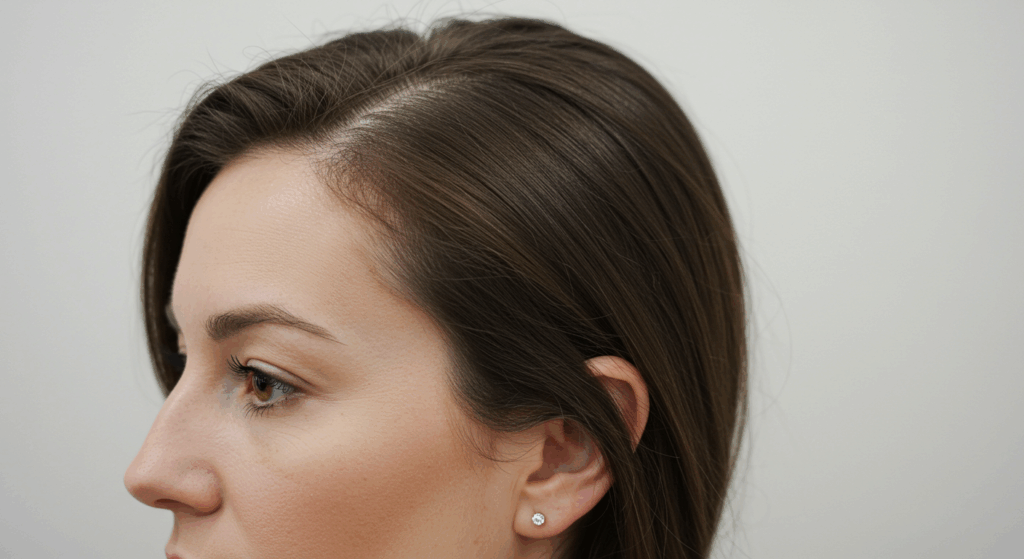Voor velen transgender vrouwen en non-binaire individuen, gezichtsfeminisering operatie (FFS) is een cruciale stap in het afstemmen van fysieke verschijning op genderidentiteit. Een van de meest transformerende procedures is haarlijn vooruitgang, die het voorhoofd en de haarlijn hermodelleert om een zachtere, meer traditionele vrouwelijke look te creëren. Maar zoals bij elke chirurgische ingreep, gaat het gepaard met risico's, hersteluitdagingen en kritische overwegingen.
Deze gids is uw uitgebreide bron Voor inzicht in de risico's, hersteltijdlijnen en alles daartussenin bij FFS-haarlijnverbetering. Of u nu in de onderzoeksfase zit of zich voorbereidt op een operatie, wij staan voor u klaar.

Inhoudsopgave
Wat is FFS-haarlijnvooruitgang?
Haarlijnverlenging, ook bekend als voorhoofdverkleining of haarlijnfeminisatiechirurgie, is een procedure die is ontworpen om:
- Verlaag de haarlijn om de hoogte van het voorhoofd te verkleinen.
- Geef de haarlijn een nieuwe vorm om een ronder, vrouwelijker gezicht te creëren.
- Verwijder een opvallende wenkbrauwboog.
Deze procedure wordt vaak gecombineerd met wenkbrauw liften of hoofdhuidverbetering om optimale resultaten te bereiken. Voor een diepere duik in de artistieke benaderingen van haarlijnverandering, bekijk ons artikel over Contrasterende benaderingen van haarlijnverandering bij FFS en FMS.
De risico's van FFS-haarlijnverbetering: wat u moet weten
Hoewel het verbeteren van de haarlijn levensveranderende resultaten kan opleveren, is het essentieel om de mogelijke risico's en complicaties:
Algemene risico's
| Risico | Beschrijving | Waarschijnlijkheid |
|---|---|---|
| Littekens | Zichtbare littekens langs de haarlijn of het voorhoofd. Bekwame chirurgen minimaliseren dit risico met een nauwkeurige incisie. | Laag tot matig |
| Gevoelloosheid | Tijdelijke of permanente gevoelloosheid van het voorhoofd of de hoofdhuid als gevolg van zenuwbeschadiging. | Gematigd |
| Haaruitval | Tijdelijke haaruitval of dunner wordend haar rond de incisieplek. In zeldzame gevallen kan permanent haarverlies optreden. | Laag |
| Infectie | Postoperatieve infecties komen zelden voor, maar vereisen onmiddellijke medische hulp als ze optreden. | Laag |
| Asymmetrie | Ongelijke haarlijn of vorm van het voorhoofd als gevolg van de genezings- of chirurgische techniek. | Laag |
Zeldzame maar ernstige complicaties
- Hematoom: Een ophoping van bloed onder de huid die mogelijk gedraineerd moet worden.
- Huidnecrose: Zeldzame maar ernstige complicatie waarbij weefsel afsterft als gevolg van slechte bloedtoevoer.
- Onbevredigende resultaten: Het kan voorkomen dat de resultaten niet aan de verwachtingen voldoen, waardoor een revisieoperatie noodzakelijk is.
Voor meer inzicht in mogelijke complicaties, raadpleeg onze gedetailleerde gids over Complicaties bij FFS-chirurgie.
Hersteltijdlijn: wat u na de operatie kunt verwachten
Herstel van haarlijnverbetering is een geleidelijk proces dat per persoon verschilt. Hieronder staat een week-tot-week-indeling wat u kunt verwachten:
Week 1: Directe postoperatieve fase
- Dagen 1-3: Zwelling, blauwe plekken en ongemak komen vaak voor. Pijnstillers en koude kompressen helpen de symptomen te beheersen.
- Dagen 4-7: Hechtingen of nietjes kunnen worden verwijderd. De zwelling begint af te nemen, maar er kan een blauwe plek blijven.
Weken 2-4: Vroeg herstel
- Zwelling en blauwe plekken nemen aanzienlijk af.
- Gevoelloosheid of tintelingen kunnen aanhouden terwijl de zenuwen genezen.
- Lichte activiteiten kunnen worden hervat, maar zware inspanning moet worden vermeden.
Weken 5-12: Tussentijds herstel
- De zwelling verdwijnt grotendeels en de haarlijn begint zich op zijn definitieve plaats te zetten.
- Het kan zijn dat er rond de incisieplek weer haar gaat groeien.
- Vervolgbezoeken om het herstel te bewaken en eventuele zorgen te bespreken.
Maanden 3-6: Langdurige genezing
- De uiteindelijke resultaten worden zichtbaar wanneer de zwelling volledig afneemt.
- Littekens vervagen en rijpen verder.
- Meestal keert het volledige gevoel terug, hoewel er soms enig gevoel van gevoelloosheid kan aanhouden.
| Tijdsbestek | Wat u kunt verwachten | Tips voor herstel |
|---|---|---|
| Week 1 | Zwelling, blauwe plekken, ongemak | Rust, koude kompressen, voorgeschreven pijnstillers |
| Weken 2-4 | Verminderde zwelling, mogelijke gevoelloosheid | Vermijd zware activiteiten en houd de incisies schoon. |
| Weken 5-12 | Haarlijn stabiliseert, haargroei begint | Vervolgafspraken, zachte haarverzorging |
| Maanden 3-6 | Eindresultaten, littekens vervagen | Geduld, littekenverzorgingsroutines |
Voor meer tips over het beheren van herstel, lees onze gids over Haargroei beheren na FFS.

Voorbereiding op FFS-haarlijnverbetering: een stapsgewijze handleiding
Een goede voorbereiding is essentieel voor een soepele operatie en herstel. Zo bereid je je voor:
Voor de operatie
- Overleg: Bespreek uw doelen, medische geschiedenis en verwachtingen met uw chirurgStel vragen zoals beschreven in onze Belangrijke vragen over het verlagen van de FFS-haarlijn.
- Medische evaluatie: Laat alle vereiste bloedonderzoeken en gezondheidscontroles uitvoeren.
- Medicatie-aanpassingen: Vermijd bloedverdunners en bepaalde supplementen zoals voorgeschreven door uw chirurg.
- Veranderingen in levensstijl: Stop met roken en beperk alcoholgebruik om het genezingsproces te bevorderen.
Dag van de operatie
- Zorg ervoor dat een vriend of familielid u naar huis brengt.
- Draag losse, comfortabele kleding.
- Volg de instructies vóór de operatie op, zoals nuchter blijven.
Essentiële zaken na een operatie
- Zorg dat u voldoende benodigdheden in huis heeft, zoals gaas, koude kompressen en voorgeschreven medicijnen.
- Richt een comfortabele herstelruimte in met kussens, entertainment en gemakkelijke toegang tot benodigdheden.
Veelgestelde vragen (FAQ's)
Is het pijnlijk om de haarlijn te verplaatsen?
Ongemak is meestal te behandelen met voorgeschreven pijnstillers. De meeste patiënten melden lichte tot matige pijn die binnen een week afneemt.
Zal ik zichtbare littekens hebben?
Bekwame chirurgen maken incisies langs de haarlijn om de zichtbaarheid te minimaliseren. Littekens vervagen doorgaans aanzienlijk na verloop van tijd en kunnen worden verborgen met haarstyling.
Hoe snel kan ik weer aan het werk?
De meeste patiënten kunnen binnen 1 à 2 weken weer aan het werk, afhankelijk van de aard van hun werk en de voortgang van het genezingsproces.
Kan ik haarlijncorrectie combineren met andere FFS-procedures?
Ja! Veel patiënten kiezen ervoor om haarlijncorrectie te combineren met procedures zoals wenkbrauwliften, neuscorrectie, of kaakcontouring voor een algehele vervrouwelijking van het gezicht.
Wat als ik niet tevreden ben met de resultaten?
Revisiechirurgie is een optie als de resultaten niet aan de verwachtingen voldoen. Open communicatie met uw chirurg is essentieel om het gewenste resultaat te bereiken.
Hoe verzorg ik mijn haar na de operatie?
Volg de instructies van uw chirurg voor het wassen en stylen van uw haar. Vermijd het gebruik van stylingtools en agressieve chemicaliën totdat uw chirurg u toestemming heeft gegeven. Bekijk voor meer tips onze gids over Haargroei beheren na FFS.
Zijn er niet-chirurgische alternatieven?
Niet-chirurgische opties zoals haartransplantaties of fillers kunnen een tijdelijke verbetering bieden, maar leveren doorgaans niet dezelfde dramatische resultaten op als een operatie.
Welke vragen moet ik aan mijn chirurg stellen?
Maak een lijst met vragen, zoals die in onze Belangrijke vragen over het verlagen van de FFS-haarlijn gids, zodat u volledig geïnformeerd bent.
Conclusie: uw pad naar zelfvertrouwen
Belangrijkste punten
- FFS-haarlijnverbetering is een krachtig hulpmiddel om een vrouwelijker uiterlijk te krijgen.
- Inzicht in de risico's en het herstelproces is essentieel voor een succesvol resultaat.
- Een goede voorbereiding en nazorg kunnen uw resultaten aanzienlijk verbeteren.
- Open communicatie met uw chirurg zorgt ervoor dat uw verwachtingen aansluiten op de realiteit.
Volgende stappen
- Maak een afspraak met een gekwalificeerde FFS-chirurg om uw doelen te bespreken.
- Bekijk onze Veelgestelde vragen over FFS-chirurgie voor meer inzichten.
- Bereid u voor op de operatie door de richtlijnen in deze gids te volgen.
Bezoek Dr.MFO Instagram-profiel om echte patiënttransformaties te zien! Krijg een glimp van de ongelooflijke resultaten die zijn bereikt door gezichtsbehandelingen feminisatiechirurgie en andere procedures. Het profiel toont voor- en nafoto's die Dokter MFO's expertise en artistieke visie bij het creëren van natuurlijke, prachtige resultaten.
Klaar om de volgende stap in uw reis te zetten? Plan een gratis consultatie met Dokter MFO ( Beste chirurg voor gezichtsfeminisatie vandaag. Tijdens het consult kunt u uw doelen bespreken, eventuele vragen stellen en meer te weten komen over hoe Dokter MFO kan u helpen uw gewenste look te bereiken. Aarzel niet om gebruik te maken van deze gratis mogelijkheid om uw opties te verkennen en te zien of Dokter MFO de juiste keuze voor u is.









